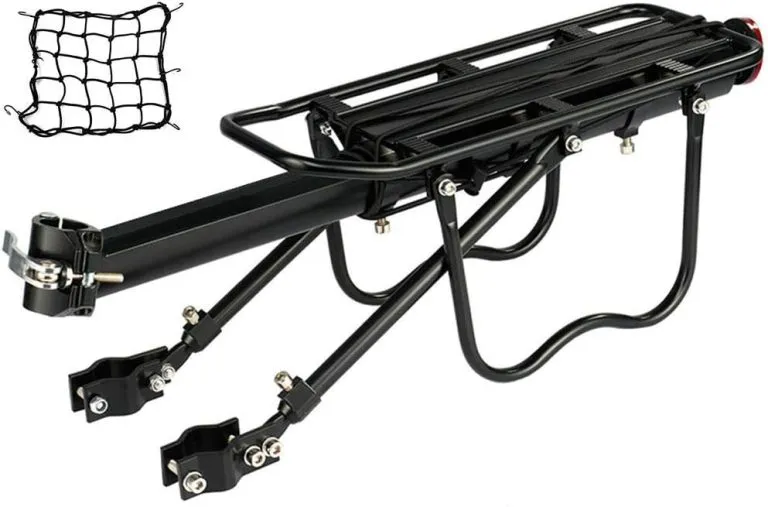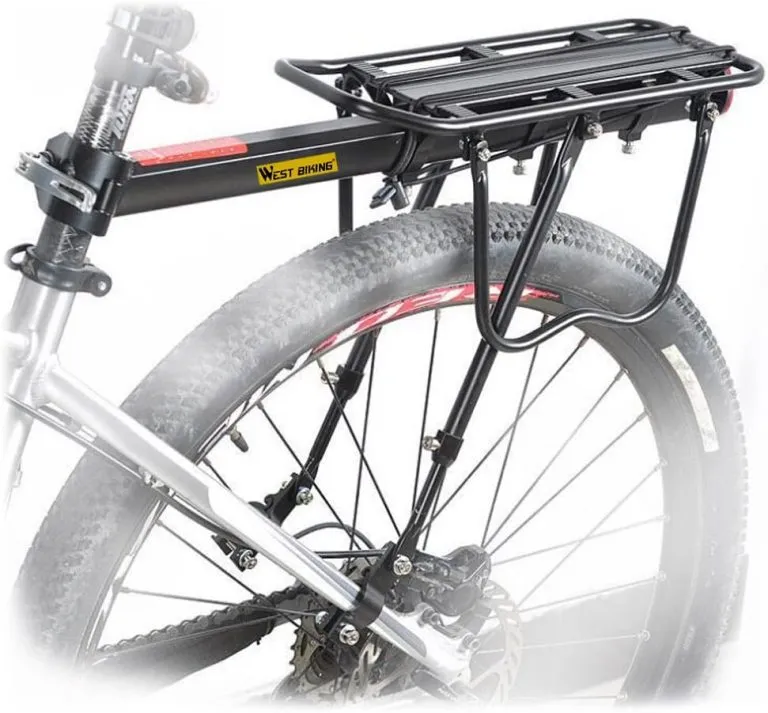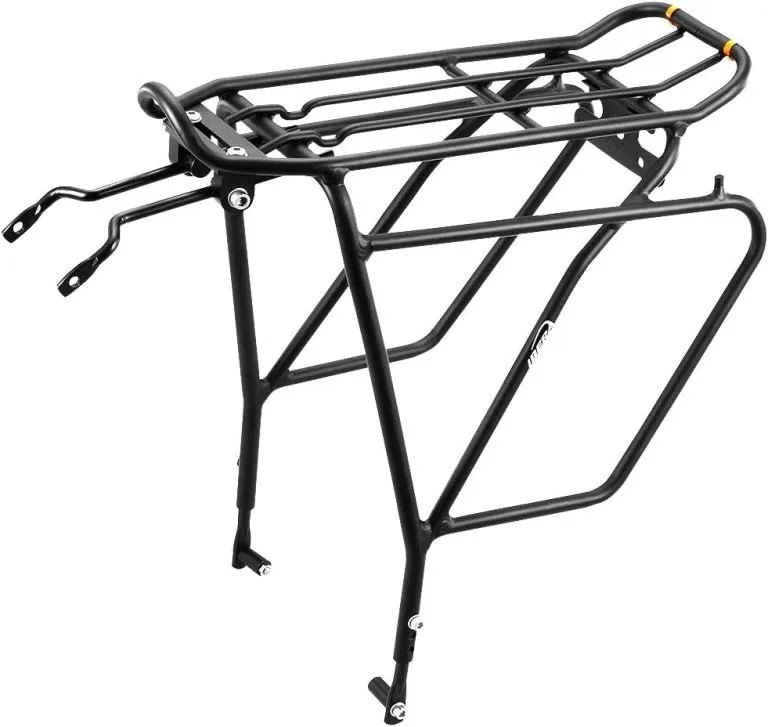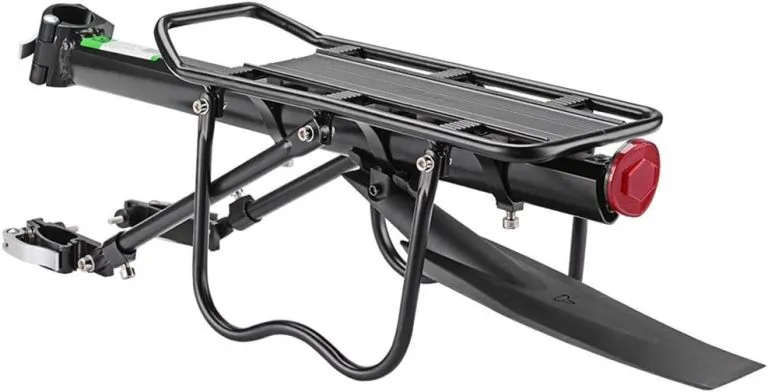Finding rear rack options for multiple bikes without mounts can be frustrating, especially considering curated bikepacking routes.
Many cyclists think they are limited to bulky solutions like a regular bike rack or a bike bag, but pavement bicycling or a bike seat bag are different.
There are sleek and practical alternatives, like a saddle bag or rear bike rack, that can enhance your ride for pavement bicycling without needing permanent fixtures or rack mounts.
From universal fit systems to innovative cargo solutions, including bag support, you can easily add storage to your bike for pavement bicycling.
- High Quality Aluminum Alloy: ROCK BROS bike cargo rack is made of high strength aluminum alloy material with stainless steel screws, helps you ride freely in rainy days or bad weather. The rear bike rack has strong load-bearing of MOST 55lb capacity, suitable for daily use and long distance cycling.
- Universal Cargo Rack: Mainly suitable for most mountain bikes, fits ROUND seat tube diameter under 3.2cm(1.26ines). NOTE:DOES NOT fit soft-tailed bike, carbon fiber bike, foldable bike, small wheel bicycle, rear suspension bike, etc.
- Easy To Install: Adjustable quick release bike rear rack clamp for installation and remove simply, with tools, installation instructions and video, you can install the bike luggage cargo rack easily.
- Firm&Durable: Three-point fixation is more stable, adjustable support rod for easy length adjustment, allows you adjust the rod length to fit your mountain bike frame, perfect as a bike luggage rack and for carrying equipment on your travel and commuting.
- Side Protection: Two “W” shape side bars protect your luggage from scratching by the wheel or spokes. With elastic cords and red rear reflective lamp, the bike back rack provides extra security while riding.
Last update on 2025-11-10 / Affiliate links / Images from Amazon Product Advertising API
These options provide versatility and convenience for pavement bicycling while keeping your bike lightweight to mount. You don’t have to compromise on style or functionality.
Whether you’re commuting on pavement, bicycling, or exploring trails, the right rear rack will mount and elevate your biking experience.
Key Points
- If your bike lacks mounting points, consider using a seat post rack or a clamp-on rack for pavement bicycling. These options provide flexibility and ease of installation.
- Rear racks can greatly enhance your biking experience by allowing you to mount and carry more gear, making them ideal for bikepacking and daily commuting.
- When choosing a lightweight rack to mount for bikepacking, prioritize materials like aluminum or carbon fiber to keep your load manageable.
- Everyday uses for rear racks include grocery shopping or carrying work supplies, making them a practical addition to any bike that can mount accessories.
- Ensure proper mounting by following tips for securing racks without brackets, such as using zip ties or adjustable straps for stability.
- Always check for tire clearance and the appropriate height of the rack to mount your bike and prevent interference with its performance.
Overview of Rear Rack Options
Rack Designs
Rear racks for bikes without mounts come in various designs, catering to different needs and bike types. Some options include universal racks that fit most frames.
They attach to the rear bike rack, seat post, and axle, providing a stable mount platform.
Others feature adjustable arms to fit unique frame shapes.
Racks can be made from aluminum or steel. Aluminum is lightweight and rust-resistant, while steel offers strength but adds weight.
Riders should consider their priorities when choosing materials.
Adaptable Solutions
Strut kits are a popular solution for mounting bike racks without built-in mounts. These kits include struts that connect the rack to the seat post and rear axle.
They provide extra support and stability, making them ideal for heavier loads on a rear bike rack.
Axle kits are another option. They replace the existing axle with one that has a mounting point for the rack. This method ensures a secure attachment while maintaining the bike’s integrity.
Both solutions, including the rear bike rack, are easy to install and remove, allowing flexibility.
Versatility of Racks
Rear racks offer versatility for different types of bikes and uses. Commuters often use them to carry groceries or work supplies.
Tourists rely on them for extended trips, needing space for camping gear or clothing.
Mountain bikers can also benefit from rear racks, especially during long rides. They can securely carry tools, water, or snacks.
Hybrid and road bikes use racks for light cargo, enhancing daily usability.
Different styles of racks exist as well.
Some have integrated lights or reflectors for safety, and others come with additional features like side frames or baskets for extra storage options.
Considerations
Choosing the right rear rack involves several factors.
Riders should consider weight capacity based on their needs.
Not all racks can hold the same amount of weight, so checking specifications is essential.
Compatibility with bike style is also crucial. A mountain bike may need a sturdier rack than a road bike.
Riders must think about how they plan to use the rack.
Will it be for commuting, touring, or casual rides?
Proper installation is vital for safety and performance.
Following manufacturer instructions ensures secure attachment and prevents accidents.
Benefits of Using Rear Racks
Increased Cargo Capacity
Rear racks significantly increase cargo capacity, which is crucial for longer rides or commutes. Riders can carry more gear without sacrificing comfort.
A rear rack also allows the use of larger bags that attach securely. This setup is ideal for touring cyclists who need extra supplies.
It also suits commuters who want to transport work items easily.
Enhanced Stability
Using a rear rack enhances stability and weight distribution. Properly loaded racks help keep the bike balanced.
When weight shifts, it can affect handling. A well-placed load on a rear rack minimizes this issue.
Riders experience better control during turns and stops.
This feature makes riding safer, especially with heavy loads.
Convenience Over Seat Packs
Riders often prefer rear racks to traditional seat packs, which can be limited in size and may not distribute weight evenly.
Rear racks allow more room for larger bags and easy access to items while riding.
This convenience is beneficial during commutes or long rides.
Versatility of Low Rider Side Rails
Low rider side rails add versatility to rear racks. These rails provide additional support for bags, improving stability further.
They allow users to attach panniers securely without worrying about balance.
This feature is especially useful for those carrying heavier items.
Practical Use Cases
Many cyclists find practical applications for rear racks. Commuters can easily pack lunch, clothes, or even a laptop bag.
Tourists can bring camping gear or extra clothing without hassle.
Families can transport kids’ items or groceries comfortably on weekend rides.
- 【PANNIER RACK FOR TOURING】: The rear rack adds a lot of versatility, and is the most popular type of bike rack. Saving your back from carrying heavy loads, rear racks allow you to carry much more cargo on the road with you. Lots of cyclists use our rear racks when they’re bike touring or camping, also make great racks for a commuter looking to carry a pannier on their bike and extra gear to get to school or work
- 【COMPATIBILITY】: The rear rack is adjustable, allows to fit almost any bicycle. Compatibility with 26″-29″ and 700c wheels, Disc and Non-Disc Brakes. So you can use it on MTBs, touring bikes and even gravel bikes. Heel clearance is excellent even with 3 panniers on the rear rack. One trunk bag up top and pannier on each side
- 【SOLID & STURDY】: This bike rear rack is constructed with durable 6061-T6 aluminum, the rack maintains stiffness without weighing your frame down. This cargo rack included space to attach a reflector at the rear and designed the rack with a narrow width to keep weight as close to the center as possible for a stable ride. Once you’re packed up, it can carry up to 60 lbs of gear
- NOTE: After you have used it for a period of time, please check whether the screws in various parts are loose
Last update on 2025-11-10 / Affiliate links / Images from Amazon Product Advertising API
Improved Riding Experience
The overall riding experience improves with a rear rack.
Riders feel less strain on their bodies when gear is distributed properly.
The bike maneuvers better with an even weight load, enhancing enjoyment on longer trips.
Cost-Effective Solution
Investing in a rear rack is cost-effective for many cyclists.
It provides a durable solution for carrying gear compared to other options like trailers or bulky backpacks.
Many models are affordable and easy to install, making them accessible for all types of riders.
Compatibility with Various Bikes
Rear racks are compatible with many bicycles, even those without mounts.
Options exist that clamp onto the frame securely, ensuring safety during rides.
This compatibility opens doors for many riders who want to enhance their biking experience.
Lightweight Racks for Bikepacking
Rack Weight
Selecting bikepacking racks that weigh under 1,000 grams is crucial. Lighter racks enhance bike performance.
They reduce the overall weight of your setup.
This is important during long rides. Every gram counts when bikepacking.
Lightweight racks often balance strength and weight.
Many options exist that offer durability without being heavy.
These racks help maintain speed and efficiency on the road.
For instance, the Topeak Tubular Explorer Rack weighs just 800 grams, making it a solid choice for many backpackers.
Stability on Terrain
Consider stability when choosing lightweight options.
Many bikepacking trips involve rough terrain.
A rack must stay secure to handle bumps and jolts.
Look for racks with strong mounting systems.
They should attach firmly to the frame or seat post.
e racks come with adjustable features for better fit, helping them stay stable even on uneven surfaces.
A good example is the seat post-mount bike rack. It provides extra support while keeping weight low.
Compatibility with Gear
Evaluate compatibility with your bikepacking gear and panniers. Racks should easily integrate with various bike bags. This ensures seamless travel without hassle.
Some racks are designed specifically for certain types of bags.
For instance, lightweight drybags fit well on many bike racks and offer waterproof protection for gear.
A standard bike rack can also work if it has the right dimensions.
Check if the rack can hold additional accessories too.
Some have attachment points for lights or other gear. This versatility enhances your bikepacking setup.
Versatile Setup
A versatile bikepacking setup is essential for successful trips. Racks should accommodate both traditional bike touring setups and modern styles.
This flexibility allows for changes in gear as needed.
Many backpackers prefer using generic-type bike racks due to their adaptability.
These racks often fit various bikes and bags without complications, allowing you to switch out gear easily based on your trip requirements.
Cost Considerations
Affordability matters when selecting a rack.
Cheap bike rack options exist that do not compromise quality.
Research different brands to find reliable choices within budget constraints.
Investing in a quality bike rack may save money in the long run.
Durable products withstand wear and tear better than cheaper alternatives.
Everyday Uses for Rear Racks
Daily Commuting
Rear bike racks add convenience to daily commuting.
They provide a stable platform for carrying bags or other items. Many commuters use these racks to transport their work essentials.
This reduces the need for a bulky backpack, allowing for a more comfortable ride.
Riding with a rear bike rack makes it easier to navigate through traffic. The added space helps in balancing the load.
Commuters can easily secure their belongings with straps or bungee cords.
This setup ensures that nothing falls off while riding.
A rear bike rack is also helpful during inclement weather.
It allows riders to cover their items with a rainproof bag.
Errands and Groceries
Running errands becomes simpler with rear bike racks.
Riders can quickly pick up groceries or supplies without needing a car, and the racks can hold multiple bags securely, making shopping trips efficient.
For example, a rider can attach reusable grocery bags to the rack, keeping hands free for steering and braking.
Some riders even use baskets designed for rear racks.
These baskets are perfect for carrying larger items like plants or cases of drinks.
Using rear bike racks for errands promotes sustainability.
It encourages cycling instead of driving, reducing carbon emissions.
Many cities support this effort by building bike lanes and parking areas.
Recreational Rides
Rear bike racks enhance recreational rides as well.
They allow cyclists to carry picnic gear or sports equipment easily, so riders can enjoy a day out without worrying about how to transport their gear.
For instance, cyclists heading to the park can pack snacks and blankets on the rack.
This setup makes it easy to enjoy lunch outdoors after a ride.
Racks also accommodate items like fishing rods or camping gear for weekend adventures.
Many cyclists appreciate the versatility of rear bike racks during group rides.
Friends can share gear and supplies without overcrowding individual bikes.
This cooperation enhances the overall experience and fosters community among riders.
Tips for Mounting Without Brackets
Use Adapters
Adapters can help when your bike lacks mounting points.
The Salsa Rack-Lock Mount is a popular choice.
This device allows you to attach a rear rack securely. It clamps onto the seat post and the frame.
Installation is straightforward and does not require any permanent modifications.
Other adapters are available as well.
Some use Velcro straps or clamps to hold the rack in place. These options provide flexibility for various bike designs.
Always check the weight limit of the adapter you choose.
Overloading can lead to accidents.
Experiment with Techniques
Different mounting techniques can enhance stability. Consider using a combination of straps and bungee cords.
Straps can secure your load tightly, while bungee cords offer some flexibility during rides.
This method helps prevent items from shifting unexpectedly.
Try adjusting the position of the rack as well.
Positioning it closer to the bike’s center can improve balance. If possible, test various configurations before settling on one.
Riding around the block will help you assess how stable your setup is.
Assess Frame Design
The design of your bike’s frame matters significantly.
Some frames have unique shapes that may provide hidden mounting points.
Look closely at areas near the seat post or rear triangle.
You might find spots where you can safely attach a rack or other supports.
Consider using pack mounts that do not rely on eyelets.
These mounts often clip onto existing bike components, making them particularly useful for bikes designed without traditional mounting options.
Additional Considerations
When attaching a rear rack, consider weight distribution carefully.
Placing heavier items low helps maintain balance, while evenly distributing weight prevents tipping during rides.
Check compatibility with your bike type too.
Mountain bikes, road bikes, and hybrids may require different mounting approaches.
Each bike has its own frame geometry that affects how racks fit.
Regularly inspect your setup for wear and tear.
Loose bolts or frayed straps can create safety issues over time.
- Aluminum Alloy Material – Suitable for most bicycles, Such as road bike, mountain bike, fat bike, etc. (Kids’ bike and Trek Verve can not be used,Please note: do not carry children directly ). Come with tools and installation instruction, Easy to install. The Rack body is adjustable in size.
- Dimension – Shelf Length 55 cm, Width 14.5 cm; Panel Length 35.5 cm; Width 14.5 cm. (Seat Tube Diameter 2.2-3.3 cm / 0.85-1.3″) adjustable for kinds of bikes. Easy to Mount.It is perfect for use with panniers, backpacks, baskets, and more
- [UNPACK] – 1 * Rack Body, 6 * Support Bar, 7 * Screws, 2 * Rubber Gasket, 2 * Form Gasket, 1 * Reflector, 1 * Install Instruction, 1 set *Installation tool ,1 * Keychain NOTE: Come with the installation tool if not received please contact us reissue
- 【Convenient and Safety】It is easy to install and cooperate with hexagon screw driver. Simple operation, you can quickly install the rack. At the same time, there is a red rear reflector lamp at the tail, which can ensure your riding safety at night.
- 【No Worry After-sales service】: If this bike rear rack does not meet your expectations, or if you encounter trouble during installation, please let us know and we will solve your problems
Last update on 2025-11-10 / Affiliate links / Images from Amazon Product Advertising API
Selecting the Right Rack
Intended Use Cases
Choosing a heavy-duty rack depends on how you plan to use it.
If you ride for commuting, consider racks that can carry daily essentials.
For touring, look for options that support larger loads and longer trips. A front rack may be suitable if you want to balance weight.
It helps distribute the load better than a rear rack alone.
If you plan to carry specialized gear, check compatibility with your equipment.
Some racks work well with specific panniers or bags, while others may require additional accessories for secure mounting.
Assessing your intended use will guide you in selecting the best option.
Weight Limits
Weight limits are crucial when picking a rack.
Most racks have a specified maximum load capacity, which can vary widely based on design and materials.
Heavy-duty options typically support more weight than standard racks.
For example, the Old Man Mountain racks are known for their robust construction.
They provide excellent support for heavier loads while maintaining stability.
Always verify the weight limit of your chosen rack against your gear’s weight.
Bike Dimensions
Measuring your bike’s dimensions is essential before making a purchase.
Start by measuring the distance between the axle and where the rack will sit.
This ensures a proper fit for the rack platform.
Check the frame size as well.
Different bike sizes may require different racks or mounting methods.
Ensure that any upper rack mount aligns correctly with your bike frame.
Also, consider the overall height of the rack when loaded.
A taller rack might affect your center of gravity while riding.
This could lead to instability, especially with heavy loads.
Rack Accessories
Adding favorite rack accessories can enhance functionality.
Accessories like lights, reflectors, or cargo nets improve safety and convenience.
These features can make a big difference during night rides or inclement weather.
Consider using a platform attachment if you need extra carrying space.
This allows you to be more flexible about what you can transport on your bike.
Considerations for Tire Clearance
Measuring Clearance
Measuring tire clearance is crucial before installing a rear rack.
Without proper clearance, the rack may interfere with the tires during rides.
To measure, check the space between the tire and frame.
A minimum of one inch is recommended. This gap allows for movement and prevents rubbing.
Clearance varies based on tire size and bike design.
Wider tires need more space than narrower ones.
Measure both sides of the tire for accuracy. Use a ruler or tape measure to ensure precision.
This step helps avoid problems later.
Rack Height and Geometry
The height of the rack matters in relation to tire size and bike geometry. A higher rack can alter the center of gravity.
This change affects handling and stability during rides.
It’s important to find a balance between carrying capacity and bike performance.
Consider how the rack will sit above the tires. If it’s too high, it might affect your ride quality.
Make sure the rack does not obstruct any components like brakes or gears.
Also, check how it aligns with the bike’s frame.
Space for Handling
Adequate space is essential for safe handling.
Riders should have enough room to maneuver without hitting the rack or load.
The rack should not extend too far beyond the rear wheel, as an extended rack can cause instability, especially when turning.
Think about how weight distribution impacts handling.
Heavy loads shift the bike’s balance.
Ensure that you can handle your bike comfortably with a loaded rack.
Test riding with added weight helps determine if adjustments are needed.
Performance During Rides
Performance should not be compromised by adding a rear rack.
Proper installation ensures that riding remains enjoyable and safe.
Pay attention to how the bike responds under different conditions.
Uneven loads can lead to unpredictable behavior.
Riding uphill or downhill requires careful consideration of load placement.
A well-balanced load improves performance and safety.
Avoid overloading the rack, which can strain the bike’s components.
Importance of Rack Height
Optimal Weight Distribution
Choosing the right rack height is crucial for balanced weight distribution. A rack that sits too high can shift the center of gravity, making the bike unstable.
This instability can lead to difficulty in steering, especially when loaded with cargo.
A lower rack often keeps the weight closer to the bike’s frame, enhancing riding stability and control.
A rack height between 18 and 24 inches above the ground is ideal for most bikes.
It allows for proper weight alignment without compromising performance.
Cargo Accessibility
Rack height also plays a significant role in cargo accessibility.
A higher rack may make it harder to reach your items, and riders often struggle to grab bags or equipment placed at an elevated position.
Conversely, a lower rack provides easier access.
Riders can quickly load and unload their gear without dismounting. This convenience becomes essential during long trips or commutes.
Consider your typical usage when selecting the right height for your rear rack.
Impact on Bike Aesthetics
The aesthetics of a bike can be influenced by rack height as well.
A high-mounted rack might disrupt the bike’s sleek design.
Many riders prefer a streamlined look, which a lower rack can help maintain.
A lower rack integrates better with the bike’s overall appearance, keeping the visual lines clean and appealing.
Furthermore, a well-placed rack can enhance functionality without detracting from style.
Handling Characteristics
Different rack heights change handling characteristics.
A high rack can create a top-heavy feeling when navigating turns, leading to an uncomfortable ride, particularly on uneven surfaces.
On the other hand, a low rack promotes better handling and maneuverability.
Riders often find it easier to corner and balance their bikes when the weight is positioned correctly.
Functionality Considerations
Functionality also relates to how you plan to use your bike. Consider a lower rack for better support and handling if you frequently carry heavy loads.
A higher rack may suffice for lighter items but could still impact balance.
Evaluate how much weight you typically carry and adjust accordingly.
The right height ensures that your bike performs well under various conditions.
Rear Rack Options for Bikes with No Mounts Final Thoughts
Choosing the right rear rack for your bike without mounts opens up many possibilities.
You’ve learned about various options, their benefits, and how to mount them effectively.
Whether you’re bikepacking or running errands, a rear rack enhances your cycling experience.
Now, it’s time to put this knowledge into action. Assess your needs, select the perfect rack, and enjoy the added convenience.
Don’t let the lack of mounts hold you back—explore your options and confidently hit the road.
Your next adventure awaits!
- 【Make Sure it fits Your Bike Before Order】: Make sure if your bicycle have eyelets next to the rear hub and eyelets in the seat stay(or 1 eyelet can use T adapter). Our rear rack requires the bicycle to have installation eyelets for the rear rack to ensure its load-bearing capacity.
- 【Pannier Rack for Touring】: The rear rack adds a lot of versatility, and is the most popular type of bike rack. Saving your back from carrying heavy loads, rear racks allow you to carry much more cargo on the road with you. Lots of cyclists use our rear racks when they’re bike touring or camping, also make great racks for a commuter looking to carry a pannier on their bike and extra gear to get to school or work
- 【Compatibility】: The rear rack is adjustable, allows to fit most adult bikes. Compatibility with 26″-29″ and 700c wheels, Disc and Non-Disc Brakes. So you can use it on MTBs, touring bikes and even gravel bikes. Heel clearance is excellent even with 3 panniers on the rear rack. One trunk bag up top and pannier on each side.
- 【Solid & Sturdy】: This bike rear rack is constructed with durable 6061-T6 aluminum, the rack maintains stiffness without weighing your frame down. This cargo rack included space to attach a reflector at the rear and designed the rack with a narrow width to keep weight as close to the center as possible for a stable ride. Once you’re packed up, it can carry up to 60 lbs of gear
- 【Easy to Use】: The bike rack comes with all the bolts and mounting brackets you need. Comes with instruction, you can refer to the assembly video too, it only takes a few minutes to assemble the bike cargo rack. Also Plenty of adjustments can be made to make it fit your bike. As you ride around, check the screws fastening your bike rack on occasion. If they become loose, they can rattle out. Please tighten them.
Last update on 2025-11-10 / Affiliate links / Images from Amazon Product Advertising API
Rear Rack Options for Bikes with No Mounts Frequently Asked Questions
What types of rear racks can I use on a bike without mounts?
You can opt for seat post racks, clamp-on racks, or universal fit racks. These options attach securely without the need for built-in mounts.
Are rear racks easy to install?
Yes, most rear racks designed for bikes without mounts come with user-friendly installation instructions and require minimal tools.
Can I use a rear rack for bikepacking?
Absolutely! Lightweight rear racks are ideal for bikepacking, allowing you to carry gear efficiently without adding excessive weight.
How do I ensure my rear rack fits my bike?
Check the specifications of your chosen rack against your bike’s dimensions. For optimal fit, consider factors like frame size and wheel clearance.
What should I consider regarding tire clearance?
Ensure that the rack does not obstruct your tires during movement. Measure the distance between the rack and tires to avoid rubbing or damage.
Why is rack height important?
The height of the rack affects load stability and handling. A properly positioned rack ensures balanced weight distribution while riding.
Can I use my rear rack for everyday errands?
Yes, rear racks are versatile and perfect for carrying groceries, work essentials, or other items, making them great for daily use.










